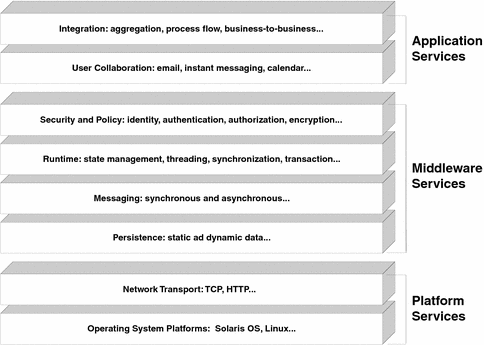Infrastructure Service Levels
In designing a distributed software system, whether it consists mostly of custom-developed components or of out-of-the-box Java ES components, you need to incorporate a number of infrastructure services. These services operate at many levels.
The infrastructure service dependency dimension of solution architecture is illustrated in Figure 2–2. The levels shown in this figure are an expanded view of the infrastructure service layer of Figure 1–1.
The hierarchy of services in Figure 2–2 and the dependencies between them constitute an important dimension of a solution’s logical architecture. These infrastructure services provide the conceptual basis for understanding the role of Java ES system service components (see System Service Components).
In general, the services shown in Figure 2–2 divide into three broad groupings: low-level platform services, high-level application services, and a group of middleware services, named for their location between the other two groupings.
Figure 2–2 Dimension 1: Infrastructure Service Levels

The following paragraphs describe the different infrastructure service levels and refer to Java programming language artifacts, where relevant. The service levels are described from lowest to highest, as shown in Figure 2–2:
-
Operating system platforms. Provides the basic support for any process running on a computer. The operating system (such as SolarisTM Operating System, Linux, or Microsoft Windows) manages physical devices as well as memory, threads, and other resources necessary to support the Java Virtual Machine (JVMTM machine).
-
Network transport. Provides basic networking support for communication between distributed application components running on different computers. These services include support for protocols such as TCP and HTTP. Other higher-level communication protocols (see the messaging level) depend on these basic transport services.
-
Persistence. Provides support for accessing and storing both static data (such as user, directory, or configuration information) and dynamic application data (information that is frequently updated).
-
Messaging. Provides support for both synchronous and asynchronous communication between application components. Synchronous messaging is real-time sending and receipt of messages; and includes remote method invocation (RMI) between J2EE components and SOAP interactions with web services. Asynchronous messaging is communication in which the sending of a message does not depend on the readiness of the consumer to immediately receive it. Asynchronous messaging specifications, for example, Java Message Service (JMS) and ebXML, support guaranteed reliability and other messaging semantics.
-
Runtime. Provides support required by any distributed component model, such as the J2EE or CORBA models. In addition to the remote method invocation needed for tightly coupled distributed components, runtime services include component state (life-cycle) management, thread pool management, synchronization (mutex locking), persistence services, distributed transaction monitoring, and distributed exception handling. In a J2EE environment, these runtime services are provided by EJBTM, web, and message-driven bean containers in an application server or web server.
-
Security and policy. Provides support for secure access to application resources. These services include support for policies that govern group or role-based access to distributed resources, as well as single sign-on capabilities. Single sign-on allows a user’s authentication to one service in a distributed system to be automatically applied to other services (J2EE components, business services, and web services) in the system.
-
User collaboration. Provides services that play a key role in supporting direct communication between users and collaboration among users in enterprise and Internet environments. As such, these services are application-level business services, normally provided by stand-alone servers (such as an email server or a calendar server).
-
Integration. Provides the services that aggregate existing business services. Provides a common interface for accessing the services, as in a portal, or by integrating the services through a process engine that coordinates them within a production workflow. Integration can also take place as business-to-business interactions between different enterprises.
The service levels shown in Figure 2–2 reflect a general dependence of the various infrastructure services on one another, from the lowest-level operating system services to the highest-level application and integration services. Each service generally depends on services below it and supports services above it.
Figure 2–2, however, does not represent a strict layering of infrastructure services. Higher-level services can directly interact with lower-level services without depending on intermediate levels. For example, some runtime services might depend directly on platform services without requiring any of the service levels in between. In addition, other service levels, such as a monitoring or management service, might also be included in this conceptual illustration.
- © 2010, Oracle Corporation and/or its affiliates
